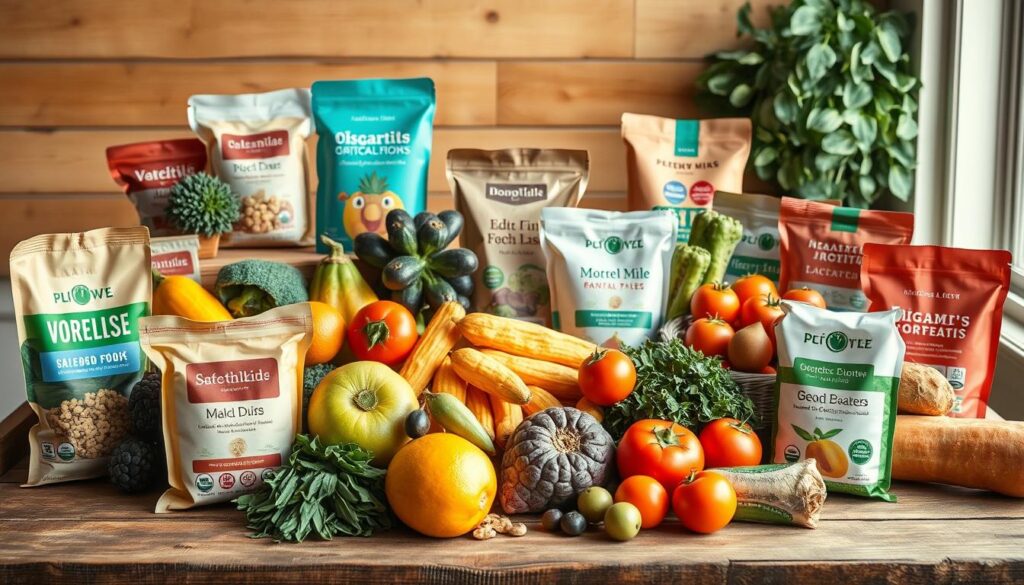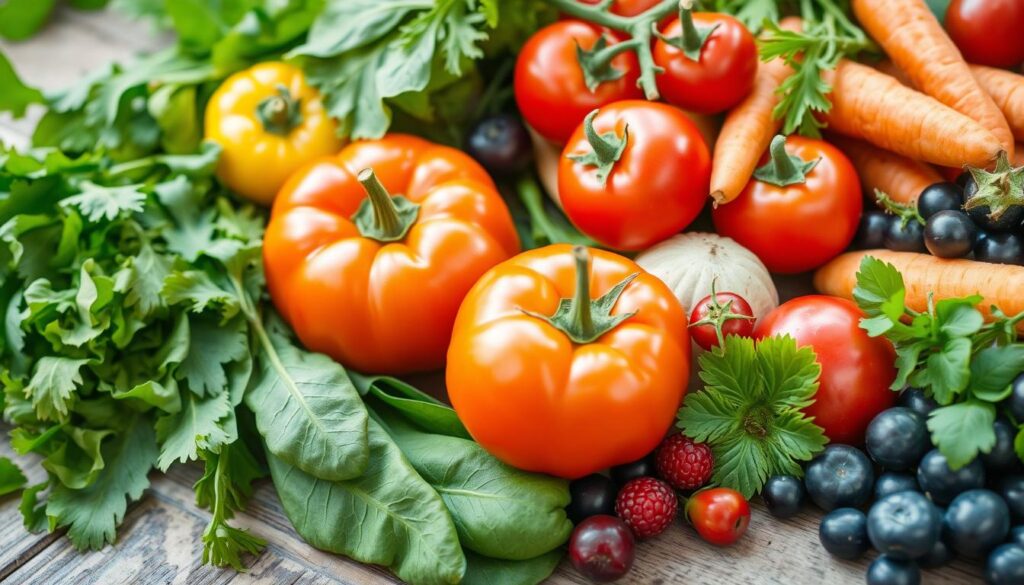Did you know the average American eats over 150 pounds of synthetic additives yearly? These artificial substances in our processed foods can harm our health. But, more people are choosing natural foods without these additives. Welcome to pure eating, where we focus on whole, unaltered ingredients that are good for us and taste great.
In this guide, we’ll explore natural foods deeply. We’ll look at the big differences between synthetic and natural additives. We’ll also talk about the benefits of clean labels and how to switch to a healthier diet. This article is for anyone looking to make better food choices and enjoy the benefits of eating pure, unprocessed foods.
Key Takeaways
- The average American consumes over 150 pounds of synthetic additives per year, which can have significant health impacts.
- Natural foods without synthetic additives offer a range of benefits, including improved nutritional value, enhanced flavor and freshness, and better digestive health.
- Understanding the different types of synthetic additives and their associated health risks is crucial for making informed purchasing decisions.
- Identifying natural ingredients, recognizing trustworthy certifications, and supporting local farms and farmers’ markets are key strategies for incorporating more natural foods into your diet.
- Gradual changes, stocking your pantry with natural alternatives, and meal planning can help you successfully transition to a diet free from synthetic additives.
Understanding Synthetic Additives and Their Impact
Choosing healthier foods means knowing about synthetic additives. These man-made ingredients add flavor, color, or extend shelf life. But, they can affect our health. Let’s look at synthetic additives, their types, and health risks.
What Are Synthetic Additives?
Synthetic additives are chemicals made in labs for food. They help keep food fresh, change texture, or taste better. Foods labeled additive-free, preservative-free, non-GMO, and organic aim to use fewer of these.
Common Types of Synthetic Additives
Processed foods often have these synthetic additives:
- Artificial preservatives, like sodium benzoate and BHA, to keep food fresh
- Synthetic colors, such as FD&C Red No. 40 and Yellow No. 5, for looks
- Artificial sweeteners, like aspartame and saccharin, for sweetness without calories
- Flavor enhancers, like MSG, to make flavors stronger
Health Risks Associated with Additives
While additives are safe in small amounts, their long-term effects worry many. Research links some additives to health problems, including:
- Allergic reactions and sensitivities
- Disrupting hormonal balance
- Higher risks of obesity and heart disease
- Possible cancer risks
Choosing additive-free, preservative-free, non-GMO, and organic foods reduces our exposure. This can lead to better health and well-being.
“The fewer artificial ingredients in our food, the better – for our bodies, our communities, and our planet.”
Benefits of Choosing No Synthetic Additives
Choosing foods without synthetic additives opens up a world of benefits. These natural ingredients and whole foods improve our nutrition and taste. They also help our digestion.
Improved Nutritional Value
Processed foods with synthetic additives are avoided. This lets us get all the vitamins, minerals, and antioxidants from nature. Natural foods like fruits, veggies, and proteins keep their nutritional power.
Enhanced Flavor and Freshness
The flavors of whole foods are unmatched. They offer vibrant tastes and freshness. Each bite is full of natural goodness, pleasing our senses and nourishing our taste buds.
Better Digestive Health
Many synthetic additives can harm our gut health. Choosing unadulterated foods helps our digestive system. They provide fiber and nutrients that support a healthy gut.
Eating pure, natural foods is not just a health trend—it’s a timeless way of nourishing our bodies the way nature intended.
By choosing pure, unadulterated whole foods, we gain many benefits. We enjoy nature’s flavors and support our health and energy.
Identifying Natural Foods
Choosing healthier options can seem hard with all the labels out there. But don’t worry, we’re here to help. We’ll show you how to find natural foods without synthetic additives. You’ll learn to read labels and spot trustworthy certifications, making it easier to pick clean, additive-free products at the store.
Reading Labels: What to Look For
Start by carefully reading the label. Avoid products with artificial colors, flavors, or preservatives. Instead, look for simple, easy-to-pronounce ingredients. Stay away from long lists of chemical-sounding words, as they often mean synthetic additives to watch out for.
Recognizing Natural Ingredients
- Choose foods with whole, plant-based ingredients like fruits, vegetables, grains, and nuts.
- Opt for products that are non-GMO and organic whenever possible, as these are less likely to contain synthetic additives.
- Look for items that boast a “clean label” – meaning they have minimal, natural ingredients without any artificial or hard-to-pronounce additions.
Trustworthy Certifications and Brands
To find additive-free foods, look for reliable certifications like USDA Organic, Non-GMO Project Verified, and additive-free labels. These third-party seals of approval show brands that offer clean, natural products. Brands like Whole Foods, Patagonia Provisions, and Annie’s Homegrown are known for their commitment to natural ingredients.
| Certification | What it Means |
|---|---|
| USDA Organic | Indicates the product is made with certified organic ingredients, without synthetic pesticides, fertilizers, or additives. |
| Non-GMO Project Verified | Ensures the product has been rigorously tested and confirmed to be free of genetically modified organisms (GMOs). |
| Additive-Free | Signifies the product contains no artificial colors, flavors, or preservatives, only natural ingredients. |
By following these tips, you’ll be able to find and enjoy the natural,additive-freefoods your body needs.
Popular Natural Food Brands
Exploring the world of natural foods is exciting. We highlight beloved brands like Organic Valley, Whole Foods Market, and Annie’s Homegrown. They make it easy to eat foods with natural ingredients.
Organic Valley
Organic Valley leads in natural foods, offering preservative-free and no synthetic additives dairy products. Their milk, yogurts, and cheese are all about clean ingredients. They support local communities and the environment, focusing on natural ingredients.
Whole Foods Market
Whole Foods Market is a top choice for natural and organic foods. They have a wide range of preservative-free and no synthetic additives options. From fresh produce to prepared meals, they aim for quality and transparency.
Annie’s Homegrown
Annie’s Homegrown is loved for its family-friendly foods. They offer preservative-free macaroni and cheese, snacks, and baking mixes. Known for fun packaging and sustainability, they’re a favorite for parents.

“We believe that food is fundamental to life and should be a source of joy, connection, and wellness for all.”
Many natural food brands are changing the industry. They show that preservative-free, no synthetic additives, and natural ingredients can be tasty and convenient. As we ask for healthier options, these brands lead the way.
How to Transition to No Synthetic Additives
Starting a diet without synthetic additives might seem hard at first. But, we’re here to help you make the change smoothly. By slowly changing your diet and using natural ingredients, you can live a healthier life. You’ll also enjoy the many benefits it brings.
Gradual Changes to Your Diet
Begin with small steps. Swap one or two processed foods for whole foods each week. For example, choose additive-free snack crackers or a clean label cereal instead of sugary ones. Taking it slow will help you get used to eating natural ingredients.
Stocking Your Pantry with Natural Foods
- Visit your local grocery store or farmers’ market to find whole foods like fresh produce and whole grains.
- Always check labels and choose products with a clean label and simple ingredients.
- Keep essentials like olive oil, vinegars, spices, and herbs on hand. They add flavor without synthetic additives.
Meal Planning for Success
Good meal planning is crucial for an additive-free diet. Spend time each week planning meals and making a shopping list of natural ingredients. This way, you’ll always have the right whole foods for tasty, healthy meals.
Changing to a diet without synthetic additives is a journey, not a quick fix. By making gradual changes and using the right natural ingredients, you’re on your way to a clean label lifestyle. Enjoy the journey and the benefits it brings.
Natural Food Preparation Tips
Preparing your ingredients the right way can make a big difference in your meals. We focus on using pure, unadulterated foods without synthetic additives. This approach helps us keep the natural goodness of our ingredients. It also makes our dishes both tasty and healthy.
Cooking Methods that Preserve Nutrients
Choosing the right cooking methods is key to getting the most from your ingredients. Here are some top methods:
- Steaming: This gentle method helps keep vitamins and minerals in your veggies and other produce.
- Sautéing: Using a bit of pure oil, you can quickly cook your ingredients. This locks in their flavors and nutrients.
- Baking: Baking is a great way to cook without losing nutrients. It’s perfect for delicious, home-cooked meals.
Recommended Cooking Oils Without Additives
The oil you use can affect your meal’s nutritional value. Choose natural, organic oils without synthetic additives. Here are some good options:
- Extra virgin olive oil: It’s full of healthy fats and antioxidants.
- Avocado oil: Rich in oleic acid and vitamin E, it’s great for high-heat cooking.
- Coconut oil: Known for its medium-chain triglycerides, it adds a tasty, tropical flavor.
Seasoning with Natural Ingredients
For flavor, nature has plenty to offer. Spices, herbs, and other natural seasonings can enhance your dishes without additives. Here are some favorites:
- Fresh herbs: Basil, rosemary, thyme, and oregano add vibrant flavors.
- Ground spices: Cumin, chili powder, and paprika bring bold, earthy notes.
- Citrus zest: Lemon, lime, or orange zest brightens up any meal.
By following these tips, you’ll make meals that are pure, unadulterated, and nourishing. They’ll delight your taste buds and your body.
“The secret to great cooking is using the best, freshest ingredients and letting their natural flavors shine.”
Popular Recipes Featuring No Synthetic Additives
Discover the joy of cooking with natural, whole food ingredients! Our collection of delectable recipes showcases the vibrant flavors and nourishing benefits of additive-free eating. From a crisp and colorful vegetable stir-fry to fragrant herbal-infused oils and satisfying whole grain salads, these dishes prove that pure, organic and non-GMO foods can be both delicious and satisfying.
Fresh Vegetable Stir-Fry
Toss together a rainbow of fresh, natural ingredients for a quick and easy stir-fry that’s bursting with flavor. Sauté crisp vegetables like broccoli, bell peppers, and carrots in a touch of whole food oil. Then, season with a blend of aromatic herbs and spices. The result is a nutritious, organic dish that’s perfect for a weeknight dinner or meal prep.
Herbal Infused Oils
Elevate your cooking with homemade herbal-infused oils, crafted from natural ingredients and free of synthetic additives. Steep fragrant herbs like rosemary, thyme, or basil in a high-quality whole food oil. Then, use the flavorful infusion to sauté, drizzle, or marinate. These versatile oils add depth of flavor to any dish while promoting better health.
Whole Grain Salads
Nourish your body with hearty, natural ingredient-based salads featuring wholesome grains. Combine nutty farro, nutty quinoa, or chewy wild rice with crisp vegetables, crunchy nuts, and a simple organic dressing. These non-GMO salads make for a perfect lunch or side dish.
| Recipe | Key Ingredients | Health Benefits |
|---|---|---|
| Fresh Vegetable Stir-Fry | Broccoli, bell peppers, carrots, whole food oil | High in fiber, vitamins, and minerals |
| Herbal Infused Oils | Natural ingredients like rosemary, thyme, basil, whole food oil | Provides antioxidants and anti-inflammatory properties |
| Whole Grain Salads | Farro, quinoa, wild rice, organic dressing | Rich in complex carbs, protein, and healthy fats |
The Role of Local Farms and Farmers’ Markets
In our search for natural ingredients, organic choices, and pure, unadulterated foods, we must look beyond supermarkets. Local farms and farmers’ markets are key. They offer natural goodness and support local agriculture. They also foster a sense of community through food.
Supporting Local Agriculture
Buying from local farms and markets benefits our bodies and the local food system. We get the freshest, most natural produce. These small growers focus on sustainable, organic practices. This keeps the pure flavors and nutrients of their foods intact.
By choosing these natural food producers, we support our local agricultural community. This helps it grow and stay strong.
Benefits of Eating Seasonal Produce
- Enjoy the peak flavors and optimal nutritional content of natural, unadulterated fruits and vegetables.
- Reduce your carbon footprint by minimizing the distance your food travels, preserving the integrity of organic ingredients.
- Discover a wider variety of pure, seasonal offerings that inspire creativity in the kitchen.
Building Community Connections Through Food
Local farms and farmers’ markets offer more than just natural, organic foods. They bring us together. We can connect with neighbors, learn about our food’s stories, and appreciate the pure, unadulterated ingredients that feed us.
These connections help us build a stronger, food-secure future. They strengthen our communities.

| Benefit | Description |
|---|---|
| Fresher Produce | Fruits and vegetables from local farms are typically picked at the peak of ripeness, ensuring maximum flavor and nutrition. |
| Support for Local Businesses | Buying from local farms and markets keeps your money circulating within your community, supporting small businesses and strengthening the local economy. |
| Reduced Environmental Impact | Locally-sourced organic and natural foods have a smaller carbon footprint compared to produce transported long distances. |
“When we buy from local farms, we’re not just purchasing pure, natural ingredients – we’re investing in the future of our community and the health of our planet.”
Addressing Common Myths about No Synthetic Additives
More people want to avoid synthetic additives in their food. But, some myths might stop them. Let’s clear up these misconceptions and give you the facts to help you decide.
Debunking Misconceptions about Cost
Many think natural, additive-free foods cost more. It’s true some specialty items might be pricier. But, many basic ingredients and whole foods without additives are affordable. Smart shopping and meal planning can help you enjoy a clean label diet without spending too much.
Understanding Accessibility in Urban Areas
Some believe natural, additive-free foods are hard to find, especially in cities. But, the growing demand has made them more available. You can find clean label, preservative-free options in most grocery stores, farmers’ markets, and specialty shops, no matter where you live.
Clarifying Shelf Life Concerns
Some worry that natural ingredients without synthetic additives spoil faster. It’s true some foods might not last as long as others. But, with the right storage and planning, you can enjoy the freshness of no synthetic additives without worrying about waste.
FAQ
What are synthetic additives, and why should I avoid them?
Synthetic additives are man-made ingredients in food. They’re added to improve taste, texture, color, or shelf life. These chemicals might harm your health. It’s safer to choose foods with natural ingredients instead.
What are the benefits of choosing foods without synthetic additives?
Foods without additives are better for you. They taste fresher and are easier to digest. You get to enjoy the real taste of natural ingredients.
How can I identify natural foods and read labels effectively?
Look for simple, recognizable ingredients on labels. Certifications like organic and non-GMO are good signs. They mean the food is natural and free from additives.
What are some popular natural food brands to look for?
Brands like Organic Valley and Annie’s Homegrown offer natural foods. They focus on quality and avoiding additives.
How can I gradually transition to a diet free from synthetic additives?
Begin by adding natural ingredients to your pantry. Plan meals using these ingredients. Making small changes helps you stick to a healthier diet.
What are some natural food preparation tips to preserve nutrients?
Use cooking methods like steaming and roasting to keep nutrients in. Choose pure oils and season with fresh herbs. This way, you get the best flavor and nutrition.
Where can I find recipes featuring natural, additive-free ingredients?
Check out our collection of recipes. They highlight the flavors of fresh vegetables and whole grains. You’ll find delicious, natural dishes to try.
How can I support local farms and farmers’ markets for additive-free foods?
Buying from local farms and visiting markets gets you fresh produce. It also supports sustainable farming and strengthens your community.
What are some common myths about avoiding synthetic additives?
Some think natural foods are pricier, harder to find, or have a short shelf life. We’ll clear up these myths. This makes choosing additive-free foods easier.





